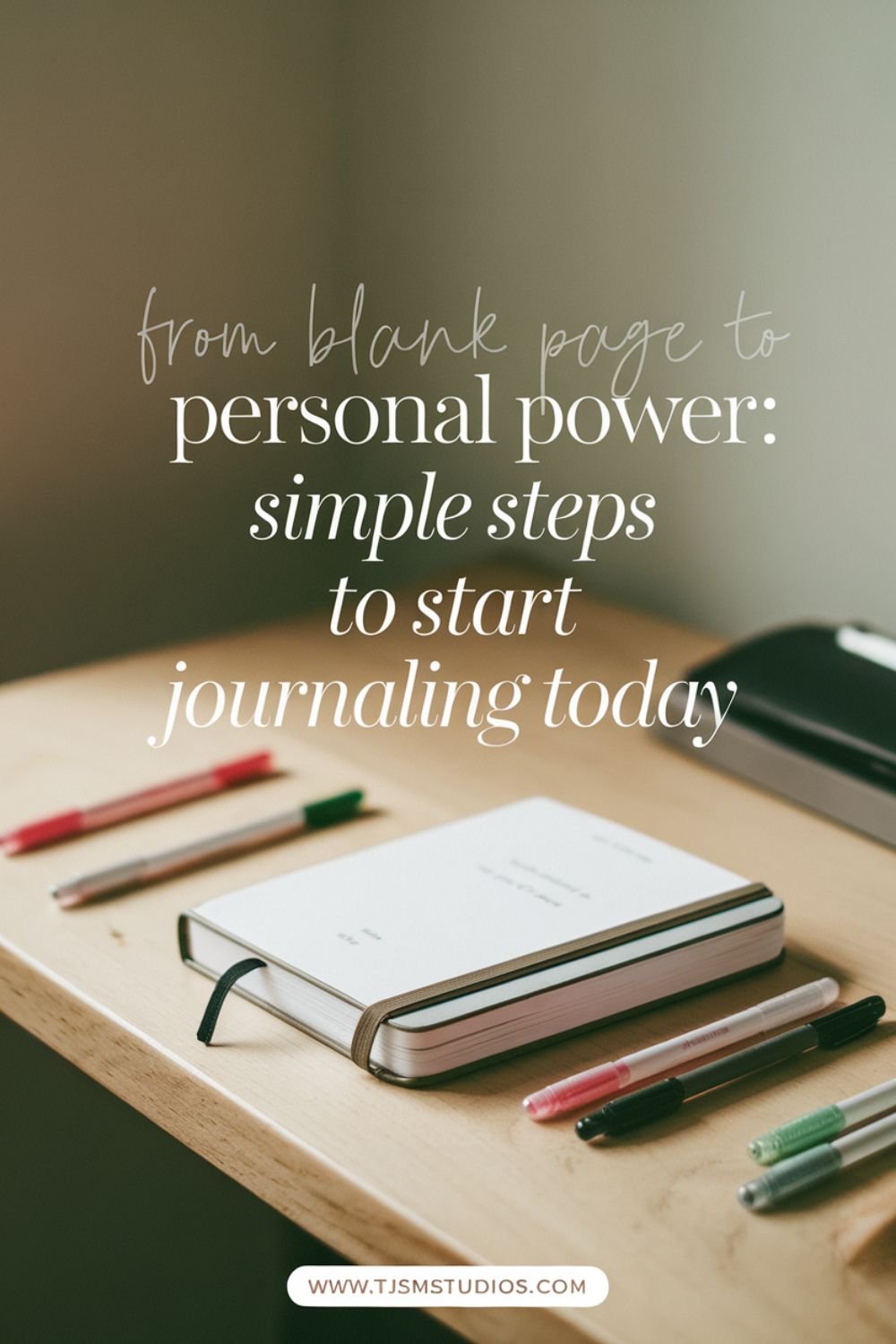This post may contain affiliate links, which means we may earn a small commission if you purchase through these links, at no additional cost to you.

Introduction
Ever feel like your thoughts are a tangled mess, buzzing around with no clear direction? I used to feel that way too. My to-do lists were endless, my worries kept me up at night, and I felt disconnected from myself. Then I discovered journaling.
At first, it was just a simple notebook and pen—nothing fancy. I had no idea it would transform my life. But soon, journaling became my secret weapon for self-discovery, stress relief, and improved focus. If you’re ready to clear your mind and tap into your personal power, this guide will help you start and maintain a journaling practice that works for you.
Step-by-Step Guide
1. Choosing Your Journal and Tools
The right journal and tools can make all the difference in your experience. There’s no one-size-fits-all—pick what excites you!
Notebooks:
- Moleskine Classic Notebook – Durable cover, smooth acid-free paper, a classic choice.
- Leuchtturm1917 Dotted Journal – Numbered pages and a built-in index, perfect for bullet journaling.
- Decomposition Notebooks – Eco-friendly, made from recycled materials, with fun cover designs.
Digital Apps:
Prefer a modern approach? Try:
- Day One – Cloud syncing, password protection, and photo uploads.
- Penzu – A secure online journal with easy organization.
Pens:
- Pilot G2 Gel Pens – Smooth ink, multiple colors, great for everyday writing.
- Sharpie S-Gel Pens – No smudging, crisp lines, ideal for fast journaling.
Extras (For Fun & Personalization):
- Colorful Washi Tape – Section off or decorate pages.
- Stickers – Add inspiration and creativity to your journal.
Experiment until you find what makes journaling feel effortless and enjoyable.
2. Setting the Stage for Success
Once you have your tools, create an environment and routine that make journaling a habit and turn it into a cherished ritual.
Find Your Sanctuary: Pick a quiet spot where you can write without distractions—your bedroom, a cozy reading nook, a sunny spot on your porch, or even a park bench surrounded by nature. The goal is to find a space that feels safe, comfortable, and inspiring to you. Experiment with different locations and times of day to discover what works best.
Schedule It In: Make journaling a non-negotiable part of your day. Whether it’s first thing in the morning to set your intentions for the day, during a lunch break to de-stress and recharge, or before bed to reflect on your experiences and wind down, consistency is key. Treat your journaling time as a sacred appointment with yourself.
Minimize Distractions: Turn off notifications on your phone and computer, close extra tabs, and let others know you need a few quiet minutes. The fewer interruptions, the easier it is to reflect and write. Consider using noise-canceling headphones or playing calming music to create a focused environment.
Set the Mood: Light a candle, brew a cup of tea, or play soft music to create a calming and inviting atmosphere. Engaging your senses can enhance your journaling experience and make it even more enjoyable.
Start Small: If the thought of journaling every day feels overwhelming, start with a smaller commitment. Perhaps you journal three times a week or only on weekends. Gradually increase the frequency as you build your habit.
Be Flexible: Life happens, and there may be days when you miss your scheduled journaling time. Don’t beat yourself up. Simply pick up where you left off and continue your practice. Remember, journaling is a personal journey, and there’s no right or wrong way to do it.
Experiment and Explore: Don’t be afraid to experiment with different journaling formats and techniques. Try freewriting, list-making, gratitude journaling, or even drawing and doodling. The possibilities are endless. Find what resonates with you and makes you feel most connected to yourself.
3. Finding Your Journaling Style
There’s no one-size-fits-all approach to journaling. It’s a deeply personal practice, and the best way to find what works for you is through exploration and experimentation. Try different styles and techniques, and see what resonates with your personality, your needs, and your lifestyle.
Free Writing: This is perhaps the most unstructured form of journaling. Simply grab your pen and paper (or open your digital document) and start writing whatever comes to mind. Don’t worry about grammar, punctuation, or even making sense. The goal is to let your thoughts flow freely and unfiltered onto the page. This can be an incredibly cathartic and liberating experience, allowing you to release pent-up emotions, explore your subconscious thoughts, and gain new insights into yourself.
Prompt-Based Journaling: If you’re feeling stuck or unsure what to write about, prompts can be a great way to kickstart your journaling practice. These can be simple questions or statements that guide your thoughts and encourage deeper reflection.
Some examples of prompts include:
- What are three things I’m grateful for today?
- What’s one goal I want to achieve this month?
- What is one thing I learned today?
- What is one challenge I’m facing right now, and how can I overcome it?
- What is one thing that made me happy today?
- What is one thing that made me sad or angry today, and why?
- What is one thing I’m proud of accomplishing?
- What is one thing I’m looking forward to in the future?
You can find prompts online, in books, or even create your own. The key is to choose prompts that resonate with you and that inspire you to write.
Gratitude Journaling: This style of journaling involves focusing on the positive aspects of your life and listing things you’re grateful for. It can be as simple as writing down three things you appreciate each day. This practice can help shift your focus from stress and negativity to positivity and abundance, and it has been shown to have numerous benefits for mental and emotional well-being.
Reflective Journaling: This involves writing about your experiences, emotions, and challenges, and reflecting on what you’ve learned from them. It’s a way to process your thoughts and feelings, gain new perspectives, and learn from your mistakes. Some helpful questions to ask yourself in reflective journaling include:
- What did I learn from this experience?
- How did this experience make me feel?
- What could I have done differently?
- What am I grateful for in this experience?
- What are my hopes and goals for the future?
Additional Journaling Styles to Explore:
- Art Journaling: This combines writing with drawing, painting, or other forms of visual expression.
- Dream Journaling: This involves recording your dreams upon waking and reflecting on their possible meanings.
- Bullet Journaling: This is a highly organized system that combines journaling with to-do lists, calendars, and other planning tools.
- Travel Journaling: This involves documenting your experiences and reflections while traveling.
Remember, the most important thing is to find a journaling style that works for you and that you enjoy. There’s no right or wrong way to do it. So experiment, have fun, and see what unfolds on the pages of your journal.
4. Overcoming Common Challenges
Even with the best intentions, roadblocks can appear on your journaling journey. Here are some strategies to overcome those obstacles and continue reaping the benefits of journaling.
Writer’s Block?
- Freewriting: If you’re staring at a blank page, try freewriting. Write whatever comes to mind without worrying about grammar, structure, or coherence. This can help loosen up your thoughts and get the words flowing.
- Sensory Details: Describe your surroundings in detail. What do you see, hear, smell, taste, and touch? This can ground you in the present moment and provide a starting point for your writing.
- Emotional Check-in: How are you feeling right now? Name the emotions you’re experiencing and explore why you might be feeling that way.
- Prompts: Use writing prompts to spark ideas. There are countless resources available online and in books. You can find prompts related to specific themes, emotions, or experiences.
- Unsent Letters: Write a letter to someone, even if you don’t intend to send it. This can be a safe space to express your thoughts and feelings honestly.
No Time?
- Micro-Journaling: Even a few minutes of journaling can be beneficial. Jot down a quick thought, a gratitude list, or a highlight of your day.
- Habit Stacking: Pair journaling with an existing habit, such as brushing your teeth or drinking your morning coffee. This can make it easier to incorporate journaling into your daily routine.
- Carry a Notebook: Keep a small notebook and pen with you so you can jot down thoughts and ideas whenever they arise.
- Voice Memos: If writing isn’t feasible, record voice memos on your phone. You can transcribe them later or simply listen to them to reflect on your thoughts.
Feeling Overwhelmed?
- Brain Dump: Write down everything that’s on your mind, without filtering or organizing. This can help clear your head and identify specific worries.
- Prioritization: Once you’ve identified your worries, prioritize them. What’s most important to address right now?
- Problem-Solving: Choose one worry to focus on and brainstorm possible solutions. Write down the steps you can take to address the issue.
- Mindfulness and Gratitude: Take a few deep breaths and focus on the present moment. Write down a few things you’re grateful for. This can help shift your perspective and reduce feelings of overwhelm.
- Self-Compassion: Be kind to yourself. Remember that everyone feels overwhelmed at times. Journaling about your experiences can be a form of self-care and self-compassion.
Remember, journaling is a personal journey. There’s no right or wrong way to do it. Experiment with different techniques and find what works best for you. The most important thing is to be consistent and make journaling a regular part of your life.
5. Maintaining Consistency
Journaling is a practice that flourishes over time and with consistent effort. It’s important to be patient with yourself as you integrate this habit into your daily or weekly routine. Remember, you are cultivating a practice that will ideally last a lifetime – there is no need to rush the process.
Strategies for Building a Sustainable Journaling Habit
- Start Small and Manageable:
- Don’t feel pressured to write pages and pages every day. Begin with a few sentences or bullet points each day, or aim for three short entries a week. As you become more comfortable, you can gradually increase the frequency and length of your journaling sessions.
- Be Patient and Flexible:
- Life happens, and there will inevitably be days or even weeks when you miss a journaling entry. Don’t be too hard on yourself. Simply pick up where you left off and continue your practice. Consistency over perfection is key.
- Prioritize Self-Compassion:
- Some days, your thoughts and feelings will flow effortlessly onto the page, while other days, you may struggle to find the right words. This is perfectly normal. Remember that journaling is a personal practice, and there is no right or wrong way to do it. Be kind to yourself and keep writing, even if it feels challenging.
- Find Your Rhythm:
- Experiment with different journaling prompts, formats, and times of day to discover what works best for you. There is no one-size-fits-all approach to journaling.
- Create a Sacred Space:
- Designate a specific time and place for your journaling practice. This can help you create a sense of ritual and make it easier to prioritize journaling in your busy schedule.
- Celebrate Your Progress:
- Acknowledge and appreciate your efforts, no matter how small they may seem. Journaling is a journey, and every step you take is worth celebrating.
Remember, the most important aspect of journaling is to show up consistently and be present with your thoughts and feelings. By incorporating these strategies and maintaining a compassionate approach, you can cultivate a sustainable journaling practice that supports your personal growth and well-being.
Final Thoughts
Journaling is a powerful tool to clear your mind, reduce stress, and gain deeper self-awareness. By choosing tools that excite you, creating a supportive environment, and exploring different styles, you can build a practice that enhances your daily life.
Ready to start? Grab a notebook and pen (or open a journaling app) and begin today! Do you already journal? Share your favorite tips or experiences in the comments—we’d love to hear your journey.

